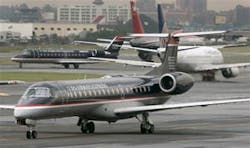Occasional long lines at airports and crowded planes are causing glitches as the heavy summer travel season takes off, but the airline industry is viewing this year's problems as manageable.
Loads, or occupancy levels, of about 81% are only slightly ahead of the past two years, saidThat June, only 66% of flights arrived on time. For the full year, only 72.6% met their scheduled arrival time, according to the Bureau of Transportation Statistics. By contrast, 77% of flights were on time in 2005, and the pace was about the same through April of this year.
The average airplane had 80.7% of its seats filled in May, according to the Air Transport Association. The average load last year was 77.6%, the highest annual average since World War II. Loads have been climbing steadily since the 1980s, when they never exceeded 63%. Even in the 1990s, they never exceeded 71%.
"It isn't ideal from a traveler's point of view, but I don't see any problem running through a summer peak with loads in the mid-80s," says consultant Dan Kasper of LECG in Cambridge, Mass. "Airlines have done a pretty decent job of adapting to high load factors."
Still, when any disruption, such as weather, a mechanical failure, airport lines or a computer malfunction, causes a delay, it's harder for airlines to reaccommodate passengers, Kasper says. Although there is no indication that the number of such incidents has increased, several have drawn attention in recent weeks.
* AirTran Airways(AAI:NYSE) said Tuesday that a scheduled computer-system upgrade had resulted in passenger check-in problems that caused long lines at a several airports, primarily at its hub in Atlanta. The airline apologized, terming the incident "an unfortunate situation for our customers and certainly not what we anticipated" and said the problems were resolved by Tuesday night. * At Los Angeles International Airport last week, passengers repeatedly faced long lines that spilled out of the airport, the Los Angeles Times reported. One cause was flooding that shut down Houston's William P. Hobby Airport, forcingSouthwest Airlines(LUV:NYSE) to cancel three flights from Los Angeles and to rebook about 400 passengers. Another reason was a malfunction in a Transportation Security Administration X-ray machine. * "The delays we are going to see this summer will be much more due to TSA lines than to full airplanes," says consultant Mike Miller of the Velocity Group in Washington, D.C. "We are a country that takes our shoes off for absolutely no reason." * In Charlotte, N.C., on the first Sunday morning after public schools let out, long lines at the ticket counter stretched through the airport. US Airways, which has its largest hub in Charlotte, had extra staff on duty, but airport parking was crowded and many passengers didn't allow extra time, says Terri Pope, US Airways' managing director for customer service. * Leisure travelers are often unfamiliar with airport procedures and may require extra time to adjust to baggage requirements and to pass through security lines. "The difference between leisure travelers and business travelers is huge when it comes to getting through the airport," Pope says.The high load factors result from rising demand for travel at a time when the supply of airline seats has declined. Domestic capacity is down about 4% from a year ago, the ATA says, largely as a result of reductions in fleet sizes by carriers operating under bankruptcy protection.
Meanwhile, demand for travel has been rising, enabling carriers to raise ticket prices in an effort to pass on the impact of fuel price increases. Through April, ticket prices were up 13%.
Parker says the industry revenue environment is strong "because there is less capacity in the system, which some are confusing with good management."
"You get concerned that people think they are doing better than they really are," he said. "Some people are even talking about aircraft orders."In the meantime, Kasper says, passengers have demonstrated that they're willing to endure crowded planes if ticket prices remain low enough. "The market has spoken," he says. "People want low fares, rather than planes that are only 60% full."
Miller says planes will continue to be full into the foreseeable future because airlines have improved their ability to identify which passengers will show up. Passengers should be aware of airport conditions, he says, arriving early when necessary and, if possible, avoiding flights at crowded times, such as Monday morning and Friday night.
Copyright 2005 LexisNexis, a division of Reed Elsevier Inc. All rights reserved.
Terms and Conditions | Privacy Policy
News stories provided by third parties are not edited by "Site Publication" staff. For suggestions and comments, please click the Contact link at the bottom of this page.






